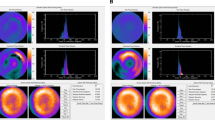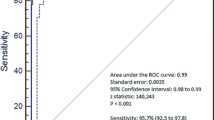Abstract
Background
CRT has been shown to be beneficial in the majority of patients with NYHA class III-IV symptoms, prolonged QRS duration, and an EF ≤35%. The use of imaging modalities to quantify dyssynchrony may help identify patients who may benefit from CRT, but do not meet current selection criteria. We hypothesize that patients with mild-to-moderate LV dysfunction have significant degrees of mechanical dyssynchrony.
Methods
We compared phase analysis measures of mechanical dyssynchrony from gated SPECT imaging in patients with mild-to-moderate LV dysfunction (EF 35-50%, n = 93), with patients with severe LV dysfunction (EF ≤ 35%, n = 167), and with normal controls (EF ≥ 55%, n = 75). Furthermore, we evaluated the relationships between QRS duration and dyssynchrony and determined the prevalence of dyssynchrony in patients with mild-moderate LV dysfunction.
Results
Patients with mild-moderate LV dysfunction have more dyssynchrony than normal controls (phase SD 37.7° vs 8.8°, P < .001 and bandwidth 113.5° vs 28.7°, P < .001), but less dyssynchrony than patients with severe LV dysfunction (phase SD 37.7° vs 52.0°, P < .001 and bandwidth 113.5° vs 158.2°, P < .001). In the cohort of patients with LV EF 35-50%, there were only weak correlations between QRS duration and dyssynchrony (phase SD, r = 0.28 and bandwidth, r = 0.20). There were 73 patients with LVEF 35-50% and QRS duration <120 milliseconds of which 21 (28.8%) had mechanical dyssynchrony. Overall, 37% of patients with mild-to-moderate LV dysfunction had significant degrees of mechanical dyssynchrony.
Conclusions
This is the largest reported study evaluating mechanical dyssynchrony in patients with mild-moderate LV dysfunction using phase analysis of gated SPECT imaging. In this study, approximately one-third of patients with mild-to-moderate LV dysfunction had significant LV mechanical dyssynchrony. With further study, phase analysis of gated SPECT imaging may help improve patient selection for CRT.



Similar content being viewed by others
References
Abraham WT, Fisher WG, Smith AL, Delurgio DB, Leon AR, Loh E, et al. Cardiac resynchronization in chronic heart failure. N Engl J Med 2002;346:1845-53.
Young JB, Abraham WT, Smith AL, Leon AR, Lieberman R, Wilkoff B, et al. Combined cardiac resynchronization and implantable cardioversion defibrillation in advanced chronic heart failure: The MIRACLE ICD trial. JAMA 2003;289:2685-94.
Bristow MR, Saxon LA, Boehmer J, Krueger S, Kass DA, De Marco T, et al. Cardiac-resynchronization therapy with or without an implantable defibrillator in advanced chronic heart failure. N Engl J Med 2004;350:2140-50.
Cleland JG, Daubert JC, Erdmann E, Freemantle N, Gras D, Kappenberger L, et al. The effect of cardiac resynchronization on morbidity and mortality in heart failure. N Engl J Med 2005;352:1539-49.
Bax JJ, Abraham T, Barold SS, Breithardt OA, Fung JW, Garrigue S, et al. Cardiac resynchronization therapy: Part 1—issues before device implantation. J Am Coll Cardiol 2005;46:2153-67.
Chung ES, Leon AR, Tavazzi L, Sun JP, Nihoyannopoulos P, Merlino J, et al. Results of the predictors of response to CRT (PROSPECT) trial. Circulation 2008;117:2608-16.
Mullens W, Grimm RA, Verga T, Dresing T, Starling RC, Wilkoff BL, et al. Insights from a cardiac resynchronization optimization clinic as part of a heart failure disease management program. J Am Coll Cardiol 2009;53:765-73.
Leclercq C, Faris O, Tunin R, Johnson J, Kato R, Evans F, et al. Systolic improvement and mechanical resynchronization does not require electrical synchrony in the dilated failing heart with left bundle-branch block. Circulation 2002;106:1760-3.
Achilli A, Sassara M, Ficili S, Pontillo D, Achilli P, Alessi C, et al. Long-term effectiveness of cardiac resynchronization therapy in patients with refractory heart failure and “narrow” QRS. J Am Coll Cardiol 2003;42:2117-24.
Chen J, Garcia EV, Folks RD, Cooke CD, Faber TL, Tauxe EL, et al. Onset of left ventricular mechanical contraction as determined by phase analysis of ECG-gated myocardial perfusion SPECT imaging: Development of a diagnostic tool for assessment of cardiac mechanical dyssynchrony. J Nucl Cardiol 2005;12:687-95.
Chen J, Faber TL, Cooke CD, Garcia EV. Temporal resolution of multiharmonic phase analysis of ECG-gated myocardial perfusion SPECT studies. J Nucl Cardiol 2008;15:383-91.
Trimble MA, Velazquez EJ, Adams GL, Honeycutt EF, Pagnanelli RA, Barnhart HX, et al. Repeatability and reproducibility of phase analysis of gated single-photon emission computed tomography myocardial perfusion imaging used to quantify cardiac dyssynchrony. Nucl Med Commun 2008;29:374-81.
Trimble MA, Borges-Neto S, Smallheiser S, Chen J, Honeycutt EF, Shaw LK, et al. Evaluation of left ventricular mechanical dyssynchrony as determined by phase analysis of ECG-gated SPECT myocardial perfusion imaging in patients with left ventricular dysfunction and conduction disturbances. J Nucl Cardiol 2007;14:298-307.
Henneman MM, Chen J, Ypenburg C, Dibbets P, Bleeker GB, Boersma E, et al. Phase analysis of gated myocardial perfusion single-photon emission computed tomography compared with tissue Doppler imaging for the assessment of left ventricular dyssynchrony. J Am Coll Cardiol 2007;49:1708-14.
Marsan NA, Henneman MM, Chen J, Ypenburg C, Dibbets P, Ghio S, et al. Left ventricular dyssynchrony assessed by two-three-dimensional imaging modalities: Phase analysis of gated myocardial perfusion SPECT and tri-plane tissue Doppler imaging. Eur J Nucl Med Mol Imaging 2008;35:166-73.
Henneman MM, Chen J, Dibbets-Schneider P, Stokkel MP, Bleeker GB, Ypenburg C, et al. Can LV dyssynchrony as assessed with phase analysis on gated myocardial perfusion SPECT predict response to CRT? J Nucl Med 2007;48:1104-11.
Bleeker GB, Kaandorp TA, Lamb HJ, Boersma E, Steendijk P, de Roos A, et al. Effect of posterolateral scar tissue on clinical and echocardiographic improvement after cardiac resynchronization therapy. Circulation 2006;113:969-76.
Ypenburg C, Schalij MJ, Bleeker GB, Steendijk P, Boersma E, Dibbets-Schneider P, et al. Extent of viability to predict response to cardiac resynchronization therapy in ischemic heart failure patients. J Nucl Med 2006;47:1565-70.
Adelstein EC, Saba S. Scar burden by myocardial perfusion imaging predicts echocardiographic response to cardiac resynchronization therapy in ischemic cardiomyopathy. Am Heart J 2007;153:105-12.
Fung JW, Zhang Q, Yip GW, Chan JY, Chan HC, Yu CM. Effect of cardiac resynchronization therapy in patients with moderate left ventricular systolic dysfunction and wide QRS complex: A prospective study. J Cardiovasc Electrophysiol 2006;17:1288-92.
Hunt SA. ACC/AHA 2005 guideline update for the diagnosis and management of chronic heart failure in the adult: A report of the American College of Cardiology/American Heart Association Task Force on Practice Guidelines (Writing Committee to Update the 2001 Guidelines for the Evaluation and Management of Heart Failure). J Am Coll Cardiol 2005;46:e1-82.
Abraham WT, Young JB, Leon AR, Adler S, Bank AJ, Hall SA, et al. Effects of cardiac resynchronization on disease progression in patients with left ventricular systolic dysfunction, an indication for an implantable cardioverter-defibrillator, and mildly symptomatic chronic heart failure. Circulation 2004;110:2864-8.
Ypenburg C, van Bommel RJ, Borleffs CJ, Bleeker GB, Boersma E, Schalij MJ, et al. Long-term prognosis after cardiac resynchronization therapy is related to the extent of left ventricular reverse remodeling at midterm follow-up. J Am Coll Cardiol 2009;53:483-90.
Bleeker GB, Schalij MJ, Molhoek SG, Verwey HF, Holman ER, Boersma E, et al. Relationship between QRS duration and left ventricular dyssynchrony in patients with end-stage heart failure. J Cardiovasc Electrophysiol 2004;15:544-9.
Trimble M, Borges-Neto S, Honneycutt E, Shaw LK, Chen J, Garcia E, et al. Electrical dyssynchrony does not correlate with mechanical dyssynchrony as determined by phase analysis of ECG-gated SPECT myocardial perfusion imaging. Oral presentation. J Nucl Cardiol 2007;14:S79.
Turner MS, Bleasdale RA, Mumford CE, Frenneaux MP, Morris-Thurgood JA. Left ventricular pacing improves haemodynamic variables in patients with heart failure with a normal QRS duration. Heart 2004;90:502-5.
Bleeker GB, Holman ER, Steendijk P, Boersma E, van der Wall EE, Schalij MJ, et al. Cardiac resynchronization therapy in patients with a narrow QRS complex. J Am Coll Cardiol 2006;48:2243-50.
Yu CM, Chan YS, Zhang Q, Yip GW, Chan CK, Kum LC, et al. Benefits of cardiac resynchronization therapy for heart failure patients with narrow QRS complexes and coexisting systolic asynchrony by echocardiography. J Am Coll Cardiol 2006;48:2251-7.
Beshai JF, Grimm RA, Nagueh SF, Baker JHII, Beau SL, Greenberg SM, et al. Cardiac-resynchronization therapy in heart failure with narrow QRS complexes. N Engl J Med 2007;357:2461-71.
Samad Z, Trimble MA, Atchley AE, Pagnanelli R, Chen J, Garcia EV, et al. Prevalence and predictors of dyssynchrony as determined by gated SPECT perfusion imaging in patients with left ventricular dysfunction. Eur Heart J 2008;29:S5.
Acknowledgments
Dr. Atchley is a fellow in training supported by a National Institutes of Health T32 grant. This study was funded by the Medtronic-Duke Strategic Alliance of which Dr. Trimble was the primary investigator. Dr. Garcia reports an ownership interest in and serves as a consultant/advisor board member to Syntermed Inc. Dr. Garcia also receives royalties from the sale of clinical software which was used as part of this research.
Author information
Authors and Affiliations
Corresponding author
Rights and permissions
About this article
Cite this article
Atchley, A.E., Trimble, M.A., Samad, Z. et al. Use of phase analysis of gated SPECT perfusion imaging to quantify dyssynchrony in patients with mild-to-moderate left ventricular dysfunction. J. Nucl. Cardiol. 16, 888–894 (2009). https://doi.org/10.1007/s12350-009-9136-3
Received:
Revised:
Accepted:
Published:
Issue Date:
DOI: https://doi.org/10.1007/s12350-009-9136-3




